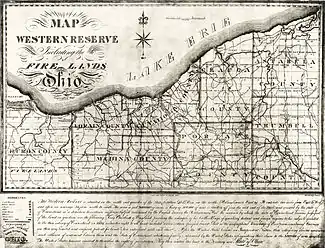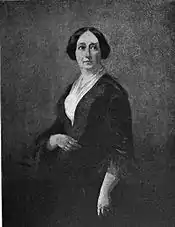Thaddeus Leavitt
Thaddeus Leavitt (1750–1826) was a Suffield, Connecticut, merchant who invented an improved upon version of the cotton gin,[1] as well as joining with seven other Connecticut men to purchase most of the three-million-plus acres of the Western Reserve lands in Ohio from the government of Connecticut, land on which some of his family eventually settled, founding Leavittsburg, Ohio, and settling in Trumbull County, Ohio. Leavitt served on a commission in the early nineteenth century to settle boundary disputes between Massachusetts and Connecticut, was a director of one of Connecticut's first banks, and was a shipowner whose vessels traded throughout the Atlantic. Leavitt also kept a journal in which he noted everything from the weather to 'cures' for various ailments to the adoption of the United States Constitution.

Thaddeus Leavitt, Esq.[2] was born September 9, 1750 in Suffield to farmer and carpenter John Leavitt and his wife Abiah Kent.[3] Thaddeus Leavitt married Elizabeth King, daughter of Ensign William King of Suffield and his wife Lucy Hatheway.[4][5] A piece of French furniture was emblazoned with a brass plaque to commemorate the couple's marriage, and given to them, probably by Leavitt's new King in-laws.[6]
Leavitt became an early Suffield merchant, selectman and Justice of the Peace, and was known as 'Squire Leavitt.' He ran a store in Suffield, and from an early age began investing in the shipping business. Leavitt was one of Hartford County's leading citizens, and became wealthy in his dealings as a merchant and shipowner.[7] His ships traded as far afield as the West Indies and other farflung destinations, and the entrepreneurial Leavitt acted as both importer and exporter. Thanks to his increasing wealth, Leavitt built the home later known in Suffield as the Harmon House on High Street.[8]
Eventually Leavitt's business interests extended as far as Spain.[9] He used the profits from his increasingly lucrative trading to join seven other prominent Connecticut men in purchasing the Western Reserve lands from the state of Connecticut, which the state had offered for sale in exchange for funds paid into the state's treasury for educational purposes. Thaddeus Leavitt Esq. and Suffield businessmen Oliver Phelps (then the largest landowner in America), Gideon Granger, Luther Loomis and Asahel Hatheway owned between them one-quarter of all the lands assigned to Connecticut in the Western Reserve.[10][11]
Also investing in the Connecticut Land Company were other of the state's most powerful men.[12] Another investor in the new western lands was Leavitt family relation Oliver Ellsworth, the Chief Justice of the United States Supreme Court, former United States Senator from Connecticut and a chief framer of the United States Constitution. (Ellsworth's share of the Reserve alone came to over 41,000 acres (170 km2) and embraced much of modern-day Cleveland). One of the first settlers of the Western Reserve was John Leavitt, brother of Thaddeus and founder of a family who went on to become prominent Ohio citizens.
In 1803 Leavitt was among several Connecticut citizens chosen to resolve a dispute between the states of Connecticut and Massachusetts concerning the border between the two states. (Suffield was once considered part of Massachusetts at the time that Thaddeus Leavitt's ancestor Lieutenant Joshua Leavitt arrived in Suffield from his birthplace in Hingham, Massachusetts).[13] Leavitt was one of a succession of trustees ordered to resolve the ongoing conflict between the two New England states.[14][15]
Leavitt's appointment to the border commission flowed from his mercantile interests in the region. In 1805, he joined with several citizens of Connecticut and Massachusetts to form a company designated by the legislature as "The Proprietors of the Springfield Bridge". The corporation's aim was building a bridge over the Connecticut River linking West Springfield and Springfield, Massachusetts.[16]
Within the state of Connecticut, Leavitt's interests came to embrace the state's burgeoning development. He served as one of the earliest directors of the newly-incorporated Hartford Bank (later the Hartford National Bank).[17] Merchant Leavitt even had his fingers in the state's agricultural economy, serving on the committee of the Hartford County Agricultural Society.[18]
Unusually for an early merchant, pressed for time, Leavitt kept a long-running diary about events in Suffield and the vicinity. (The diary today is in the collection of the Kent Memorial Library in Suffield, and its pages have been transcribed into a typewritten manuscript for easier reading.) In its pages, Leavitt noted many of the day-to-day occurrences in Suffield, including an entry from December 1, 1802, on a cure for whooping cough; another for a cure for a spider bite; and an entry from March 1803 for "a Receipt [ie, instructions] for taking film off a horses eye".[19] Leavitt took note of the raising of a new Meeting house, and on February 8, 1788, he made this entry: "We this day have certain Inteligence [sic] from the state convention Boston Massachusetts that they have adopted the Feaderal Constitution by a Majority in favr of it of 19--passd 5th Inst."[20]

Thaddeus Leavitt and his wife Elizabeth had two children who married Loomis siblings: a son, Thaddeus Leavitt Jr., who married Jemima Loomis of Suffield;[21] and a daughter Elizabeth Leavitt, who married Jemima's brother Hon. Luther Loomis.[22][23] Descendants of Thaddeus Leavitt Jr., who also became a Suffield merchant, include his grandsons, the three Hunt brothers: architect Richard Morris Hunt; Boston painter William Morris Hunt; and the lawyer and photography pioneer Leavitt Hunt.[24]
Thaddeus Leavitt Esq., a longtime stalwart of Connecticut's Democratic party, is buried in the Old Burying Ground of the First Congregational Church of Suffield, also known as the First Church of Christ, established in 1698.
See also
References
- Invention & Patent, History Between the Pages, Villanova University Library
- The courtesy title Esquire, in the case of Thaddeus Leavitt, was used to refer to him in contemporaneous writing, where he appears as 'Squire Leavitt', and on his tombstone in Suffield, and that of his brother John, who is buried nearby.
- The History of the Descendants of John Dwight of Dedham, Massachusetts, Vol. I, Benjamin Woodbridge Dwight, John F. Trow & Son, New York, 1874
- The King Family of Suffield, Connecticut, Its English Ancestry, Compiled by Cameron Haight King, Press of the Walter Brunt Company, San Francisco, 1908
- "Suffield Historical Society". Archived from the original on 2008-05-10. Retrieved 2008-12-12.
- Rare 18th C. Louis XVI Commode, Artfact.com
- Diary of Thomas Robbins, D.D., 1796–1854, Printed for His Nephew, Vol. I, Beacon Press, Boston, Mass., 1886
- Celebration of the Two Hundred and Fiftieth Anniversary of the Settlement of Suffield, Connecticut, Published by the Authority of the General Executive Committee, Suffield, 1921
- One of Leavitt's trading partners was Aaron Lopez, an early Jewish merchant in Newport, Rhode Island, who was born in Portugal and maintained trading contacts there.
- American Journal of Education (1855–1882), Vol. VI, Henry Barnard (ed.), Printed by F. C. Brownell, Hartford, Ct., 1859
- J. Hammond Trumbull (1886). The Memorial History of Hartford County, Connecticut, 1633-1884. BiblioLife LLC. ISBN 9781115331210.
- The Western Reserve Historical Society, Part II, The Connecticut Land Company and Accompanying Papers, Cleveland, Ohio, 1916
- Special Acts and Resolutions of the State of Connecticut, Boundary Line Between Connecticut and Massachusetts, John B. Eldredge, Hartford, Conn., 1837
- The History of Connecticut, from the First Settlement of the Colony to the Adoption of the Present Constitution, Vol. II, Gideon Hiram Hollister, Printed by Case, Tiffany & Co., Hartford, Ct., 1857
- Lieut. Joshua Leavitt, born at Hingham, Massachusetts, in 1687, subsequently moved to Suffield and died there in 1732. He was the grandfather of Thaddeus Leavitt.
- Our County and Its People: A History of Hampden County, Massachusetts, Vol. I, Alfred Minot Copeland, The Century Memorial Publishing Co., 1902
- 1792–1892: One Hundred Years of the Hartford Bank, now the Hartford National Bank, Patrick Henry Woodward, Press of the Case, Lockwood and Brainard Company, Hartford, Ct., 1892
- The Rural Magazine and Farmer's Monthly Museum, Vol. I, J. & W. Russell, Hartford, Conn., 1819
- Thaddeus Leavitt Diary, Kent Memorial Library, Suffield, Conn., suffield-library.org
- Thaddeus Leavitt Diary, Suffield, Conn., 8 February 1788 (excerpt), Wisconsin State Historical Society
- Annals of Brattleboro, 1681–1895, Mary R. Cabot, Press of E. L. Hildreth & Co., Brattleboro, Vt., 1921
- Born in Suffield, Luther Loomis became a prosperous New York City merchant, but fled during the War of 1812, returning to Suffield, where he became a judge of probate, a Connecticut State Senator, and was once nominated for Governor.
- The Descendants of Joseph Loomis, Elias Loomis, Tuttle, Morehouse and Taylor, New Haven, Conn., 1870
- Notable Descendants of John Dwight of Dedham, Gary Boyd Roberts, New England Historic Genealogical Society, NewEnglandAncestors.org